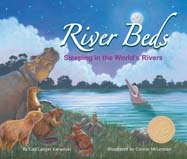Alignment to Standards for DC

| Grade | Number | Standard |
|---|---|---|
| 1 | SC.1.2.1. | Recognize and explain that water, rocks, soil, and living organisms are found on the Earths surface. |
| 1 | SC.1.4. | Different types of plants and animals inhabit the Earth. |
| 2 | G 2.1.1. | Understand how maps and globes depict geographical information in different ways. (G) |
| 2 | SC.2.5.5. | Describe when water is frozen into ice and the ice is allowed to melt, the amount of water is the same as it was at the beginning. |
| 2 | SC.2.6. | Plants and animals have structures that serve different functions in growth, survival, and reproduction. |
| 2 | SC.2.6.1. | visible, external features of plants and animals and describe how these features help them live in different environments. |
| 2 | SC.2.7. | Living things depend on one another and their environment for survival. |
| 2 | SC.2.7.1. | Observe and describe how animals may use plants, or even other animals, for shelter and nesting. |
| 2 | SC.2.7.4. | materials in nature, such as grass, twigs, sticks, and leaves, can be recycled and used again, sometimes in different forms, as birds do in making their nests. |
| 2 | SC.2.7.5. | Observe and describe how the local environment (water, dry land) supports a wide variety of plants and animals, some unique to the Chesapeake Bay. |
| 2 | SC.2.7.6. | animals and plants sometimes cause changes in their surroundings, some of these changes are easy to see, some are very small and hard to recognize, even though they can be very important. |
| 2 | SC.2.8. | Many different types of plants and animals inhabit the Earth. |
| 2 | SC.2.8.1. | living things are found almost everywhere in the world in habitats such as the oceans, rivers, rain forests, mountain ranges, arctic tundra, farms, cities, and other environments. Recognize that some habitats are extreme, such a |
| 2 | SC.2.8.2. | the numbers and types of living things can vary greatly from place to place. |
| 2 | SC.2.9.1. | people are more like one another than they are like other animals. Each type of animal is more like its relatives (family) than it is like the animals of other types (or families). |
| 3 | G 3.1.2. | Identify and locate major physical features and natural characteristics (e.g., bodies of water, land forms, natural resources, and weather) in Washington, DC. (G) |
| 3 | SC.3.5.1. | living things can be sorted into groups in many ways using various properties, such as how they look, where they live, and how they act, in order to decide which things belong to which group. |
| 4 | SC.4.7.1. | Explain that organisms interact with one another in various ways, such as providing food, pollination, and seed dispersal. |
| 4 | SC.4.7.10. | Investigate the Chesapeake Bay watershed and wetlands, and describe how they support a wide variety of plant and animal life that interact with other living and nonliving things. |
| 5 | SC.5.4.7. | Explain that water on Earth cycles through different forms and in different locations (e.g., underground water and vapor in the atmosphere). |
| 5 | SC.5.8. | Many characteristics of an organism are inherited from the parents, but others result from the influence of the environment. |
| 5 | SC.5.8.2. | List some characteristics of plants and animals that are fully inherited (e.g., form of flower, shape of leaves) and others that are affected by the climate or environmental conditions (e.g., browning of leaves from too much sun, language spoken). |
| 5 | SC.5.9.1. | in any particular environment, some kinds of plants and animals survive well, some do not survive as well, and some cannot survive at all. |
| 5 | SC.5.9.7. | Recognize that some behaviors are instinctive (turtles burying their eggs) and others learned (wolfês hunting skills). |
| K | G K.1. 2. | Demonstrate familiarity with what a map is and what a globe is. (G) |
| K-2 | G K-2.1. | Students use map and globe skills to determine the locations of places. |